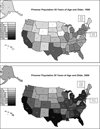Addressing the aging crisis in U.S. criminal justice health care
- PMID: 22642489
- PMCID: PMC3374923
- DOI: 10.1111/j.1532-5415.2012.03962.x
Addressing the aging crisis in U.S. criminal justice health care
Abstract
The U.S. criminal justice population is aging at a significantly more rapid rate than the overall U.S. population, with the population of older adults in prison having more than tripled since 1990. This increase is at the root of a prison healthcare crisis that is spilling into communities and public healthcare systems because nearly 95% of prisoners are eventually released. The graying prison population is also straining state and local budgets. In prison, older prisoners cost approximately three times as much as younger prisoners to incarcerate, largely because of healthcare costs. In the community, older former prisoners present the least risk of recidivism yet are vulnerable to serious and costly social and medical challenges such as housing instability, poor employability, multiple chronic health conditions, and health-related mortality; however older current and former prisoners are largely ignored in the current geriatrics evidence base. Knowledge about the health, functional, and cognitive status of older prisoners is limited, with even less known about risk factors for long-term poor health outcomes during and after incarceration. This article provides an overview of aging in the criminal justice system. It then describes how geriatric models of care could be adapted to address the mounting older prisoner healthcare crisis and identifies areas where additional research is needed to explore prison-specific models of care for older adults.
© 2012, Copyright the Authors Journal compilation © 2012, The American Geriatrics Society.
Conflict of interest statement
No other authors have conflicts of interest to report.
Figures


References
-
- Bureau of Justice Statistics. Prisoners Series: 1990 – 2010. Washington, D.C.: [Accessed November 1, 2011]. Department of Justice. Office of Justice Programs, Bureau of Justice Statistics. Available from: http://bjs.ojp.usdoj.gov/index.cfm?ty=pbse&sid=40.
-
- The U.S. Census Bureau. Washington, D.C.: [Accessed November 1, 2011]. Population Estimates: 1990 – 2009. Department of Commerce, U.S. Census Bureau. Available from: http://www.census.gov/
-
- Aday RH. Aging Prisoners: Crisis in American Corrections. Westport, CT: Praeger Publishers; 2003.
-
- Loeb SJ, Abudagga A. Health-related research on older inmates: An integrative review. Res Nurs Health. 2006;29:556–565. - PubMed

